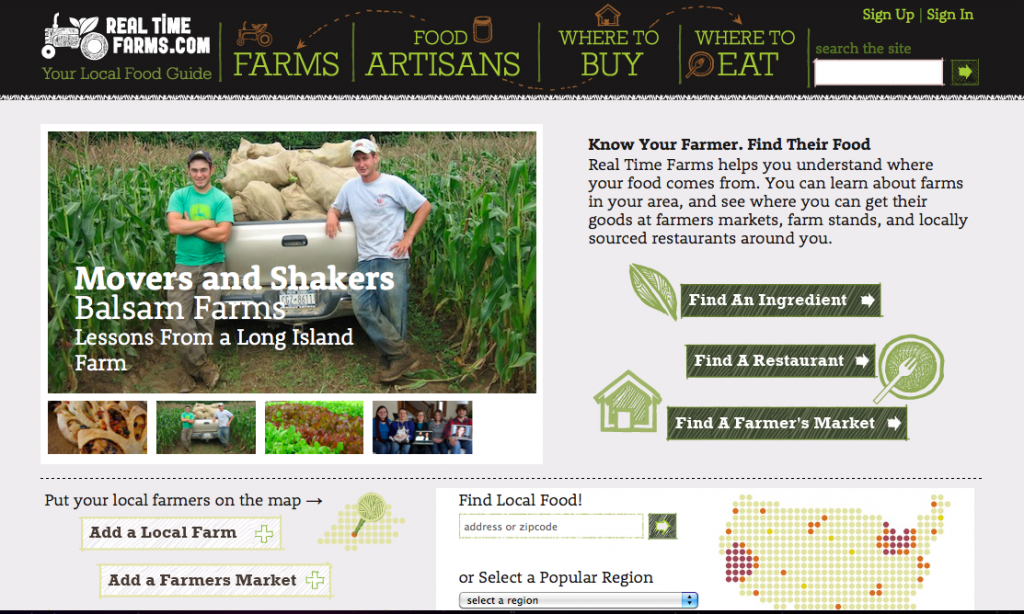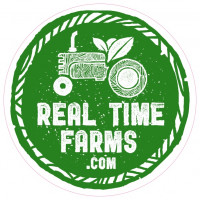“We also think that if people feel they can use the data for other purposes besides viewing it on Real Time Farms, they’ll be more likely to want to participate. It’s a win-win.” – Real Time Farms
Real Time Farms is a web platform that uses crowdsourcing to help you “connect the dots of your food web” and understand where your food is coming from. It’s no secret that truly understanding the full social, environmental, and health implications of any given food is a nearly impossible feat for any one person to undertake. Information technology, however, offers unique opportunities for collecting the disparate pieces of information that in aggregate begin to provide a better picture of these implications. This week, Real Time Farms launches their newly designed site, which takes us one step closer to understanding real-time information about farms, food artisans, and farmers markets.
Real Time Farms is dedicated to opening up their site’s data via an API (Application Programming Interface), so we can all benefit from the information being aggregated, even outside of the Real Time Farm platform. Anyone doing food system research or market research knows how challenging it is to find accurate, relevant, easily searchable, and current data on growing practices, prices paid to farmers, etc… I encourage you to check out Real Time Farms and consider investing in their SeedStarter campaign, which will ultimately benefit us all through better access to these kinds of data.
I got a chance to catch up with Co-founders Karl & Cara Rosaen to learn more about the newly designed site. Read on to get an inside view of what data they will be collecting and how.
Danielle Gould: I understand you’re launching a redesigned site, what kind of new features should we expect to see?
Cara & Karl Rosaen: We are! It will be live by Feb. 11, 2011 in time for TEDxManhattan’s “Change The Way We Eat” Conference.
The site is sexier and more user-friendly! With the help of our monthly user-testers, feedback from our regular users, and our new design firm (thanks T Square Design!), we have done a complete site overhaul! With all that we have learned, we are ecstatic to launch it! Let us know what you think.
See what’s happening across the country! Since our initial launch in April 2010, we’ve had the privilege of getting a bird’s eye view of all the information on farms, food artisans, and farmers markets that people have been adding from all across the country. Now you can have a look too. The front page gives you an overall picture of what’s being added in real-time! You can then go deeper, enter in your zip code, and be taken to information particular to your neck of the woods.
Search farms, food artisans, and distributors! You can add them and search them. While the first launch is focused on getting our new look out as soon as possible, we have plans to quickly enhance these features. You’ll soon be able to trace the ingredients of your favorite local food artisan’s jalapeno-cheddar bread back to the farms that sourced it. Similarly, you’ll be able to see the farms your area’s distributors source from. We’re a platform for connecting the dots of your food web. If you know of a farm, food artisan product, or food distributor that isn’t listed, add them. The site is user-generated, meaning we are powered by the people. Add your favorites now! We just make the tools to help you tell the story.
Show Your Support and Affiliation! Personal [profiles have expanded so you can mark you favorite farms and farmers markets as well as indicate whether or not you volunteer, farm, or manage a local farm and/or farmers market.
You can now read the oh so elusive Real Time Farms Blog (well-hidden on the last site). Our Editor-In-Chief, Lindsay-Jean Hard, posts fresh content each week with the help of other writers on our team.
You can explore the reasons locavores, chefs, market managers, and farmers across the country are using Real Time Farms! Watch video clips, read testimonials, and most importantly, explore the tools we’ve created for you to share you’re food story with the world.
DG: What services do you offer restaurants?
CR & KR: We offer tools for restaurants to tell and share the story behind their food. The service allows them to upload their menu, link every ingredient back to the farm (and its growing practices, pictures, and history), and then publish this farm-linked menu to our site and embed it within their own site. In knowing the farm or food artisan’s story, customers learn the dish’s story.
We add functionality, rather than more work. Restaurants can use Real Time Farms as their primary menu management system. They can plug into the ever-growing database of information on Real Time Farms, edit and farm-link their menus to rich farm profiles, and publish this rich menu in multiple places, instantly. Now, the customer can learn the story of their food, click on a dish, click on “pasture-raised beef” and see pictures of the cows in the pasture, read about the growing practices of the farm, and feel confident in what they are eating.
(For a more complete listing of the full functionality of the basic package, visit realtimefarms.com starting Friday, Feb 11th)
DG: How many restaurants are you looking to secure over the next year? How will your SeedStarter campaign enable you to do that?
CR & KR: Our goal is to showcase 500 restaurants nationwide this year. It is a high bar, but we think it’s possible. The money we raise through our SeedStarter campaign (named in homage to the funding platform, KickStarter) will give us the boost we need to make it happen. Part of the funding will be used for the curricula, education materials, and necessary technology needed to support our Food Warrior Summer Interns. These interns will be collecting highly-detailed information on farms, food artisans, and distributors in our five target areas nationwide. The money will also help us market and travel to each of these five locations to secure the 500 restaurants that will help us become financially viable.
As a member of the fast-growing sector of social ventures, we will use the money to build a viable business that will enable us to continue to fulfill our social mission; bring transparency to our food system and connect people to farm-fresh produce in their area. Help us make it happen!
DG: In our last interview, you said that Real Time Farms will be collecting information about farmers’ growing practices. How will you collect this data and how will you ensure that it is accurate?
CR & KR: That’s true. To date, you can find basic information on growing practices in many of the farm profiles on Real Time Farms. We’re setting up a framework to allow people to answer much more detailed and structured questions about growing practices (from soil preparation and maintenance to pest management). We have been interviewing consumers to learn about what they want to know about the way their food is grown, and talking with fruit and vegetable growers, meat producers, and fisheries, learning about how we can most effectively share their story. Crowd-sourcing this information will be integral given the depth and breadth of the questions. Our job is to present the information to users in a way that is helpful; neither overwhelming, nor shallow.
We can’t ever personally guarantee the accuracy, we can only provide the tools to allow people to collaborate to capture the most accurate answer. As we see how people use the tools, we may add additional access controls, such as reputation-based contribution systems. We have a lot of ideas, but want to wait to see how users behave, before worrying too much about controls and restrictions. We are reassured by the accuracy of crowd-sourced sites, such as Wikipedia and Stackoverflow.com. It’s worth noting some of the research validating the accuracy of crowd-sourced models. In 2005, a study, published in the journal Nature, found Wikipedia was nearly as accurate as the Encyclopedia Britannica. (Jim Giles (December 2005). “Internet encyclopedias go head to head”. Nature 438 (7070): 900–901. doi:10.1038/438900a. )
DG: You’ve mentioned that Real Time Farms is ultimately interested in opening up all of the data you are aggregating, why? How do you envision doing that?
CR & KR: We plan on opening up the data via an API (Application Programming Interface) so that people can take the data and play with it to analyze and/or build new tools. The great thing about opening API’s is that you can never anticipate what people can come up with. We will love to watch what happens!
We also think that if people feel they can use the data for other purposes besides viewing it on Real Time Farms, they’ll be more likely to want to participate. It’s a win-win. It also just feel right and fits with our social mission.






